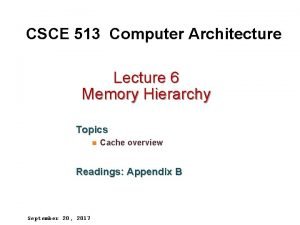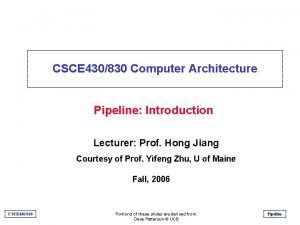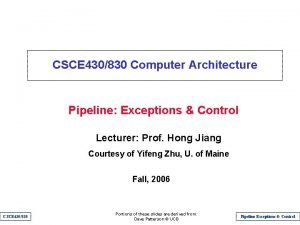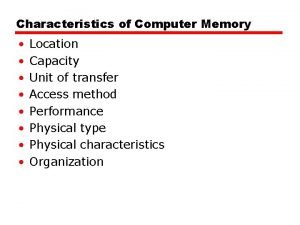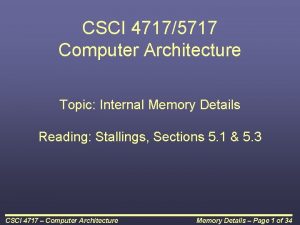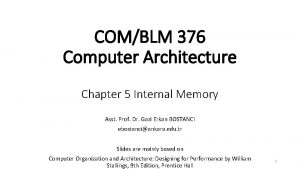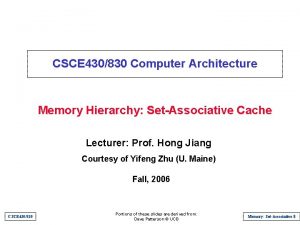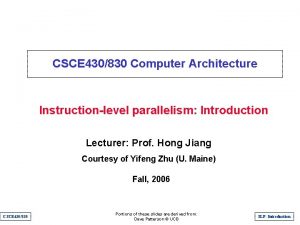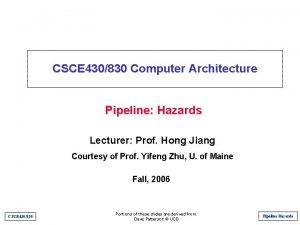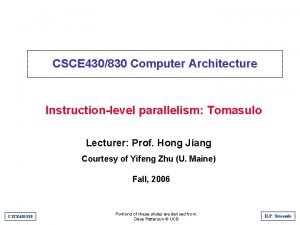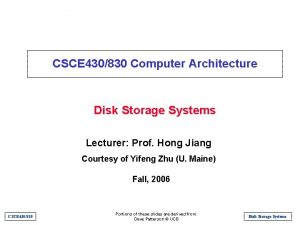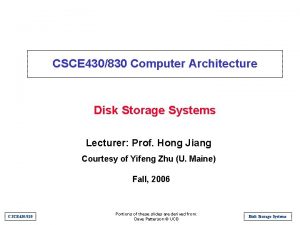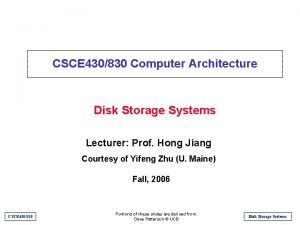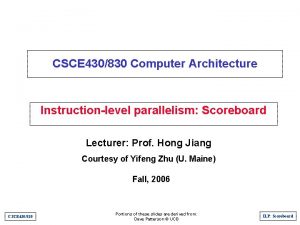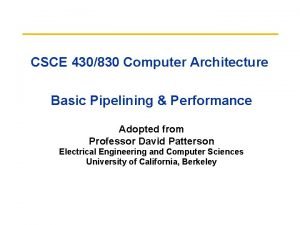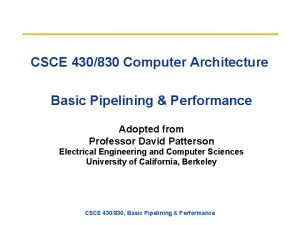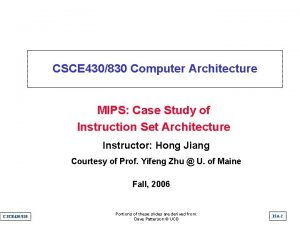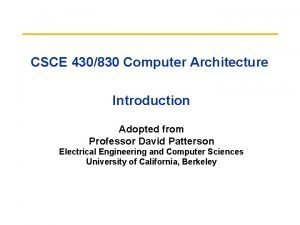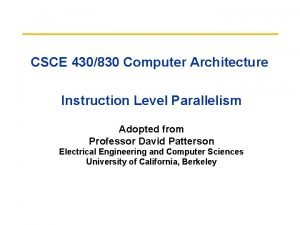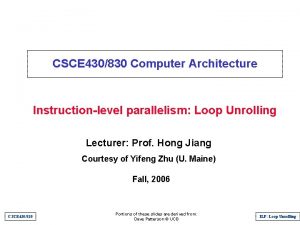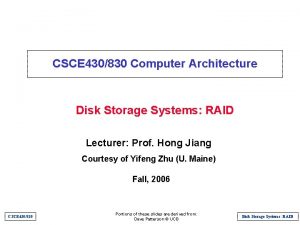CSCE 430830 Computer Architecture Memory Hierarchy Performance Lecturer





























- Slides: 29

CSCE 430/830 Computer Architecture Memory Hierarchy: Performance Lecturer: Prof. Hong Jiang Courtesy of Yifeng Zhu (U. Maine) Fall, 2006 CSCE 430/830 Portions of these slides are derived from: Dave Patterson © UCB Memory: Performance

Cache Operation • Insert between CPU and Main Memory • Implement with fast Static RAM • Holds some of a program’s – data – instructions • Operation: CPU addr Processor data Cache Memory addr data Hit: Data in Cache (no penalty) Miss: Data not in Cache (miss penalty) CSCE 430/830 DRAM Memory: Performance

Cache Performance Measures • Hit rate: fraction found in the cache – So high that we usually talk about Miss rate = 1 - Hit Rate • Hit time: time to access the cache • Miss penalty: time to replace a block from lower level, including time to replace in CPU – access time: time to access lower level – transfer time: time to transfer block • Average memory-access time (AMAT) = Hit time + Miss rate x Miss penalty (ns or clocks) CSCE 430/830 Memory: Performance

Memory Hierarchy Motivation: The Principle Of Locality • Programs usually access a relatively small portion of their address space (instructions/data) at any instant of time (program working set) as a result of access locality. • Two Types of access locality: – Temporal Locality: If an item is referenced, it will tend to be referenced again soon. » e. g. instructions in a body of a loop – Spatial locality: If an item is referenced, items whose addresses are close will tend to be referenced soon. » e. g. sequential instruction execution, sequential access to elements of array • The presence of locality in program behavior makes it possible to satisfy a large percentage of program memory access needs (both instructions and operands) using faster memory levels with much less capacity than program address space. CSCE 430/830 Memory: Performance

Fundamental Questions • Q 1: Where can a block be placed in the upper level? (Block placement) • Q 2: How is a block found if it is in the upper level? (Block identification) • Q 3: Which block should be replaced on a miss? (Block replacement) • Q 4: What happens on a write? (Write strategy) CSCE 430/830 Memory: Performance

Basic Cache Design • Organized into blocks or lines • Block Contents – tag - extra bits to identify block (part of block address) – data - data or instruction words - contiguous memory locations • Our example: – One-word (4 byte) block size – 30 -bit tag – Two blocks in cache CPU Cache b 0 b 1 tag CPU 0 tag CPU 1 data 0 data 1 Main Memory 0 x 00000004 0 x 00000008 0 x 0000000 C 0 x 0000 CSCE 430/830 Memory: Performance

Cache Example (2) • Assume: – – r 1==0, r 2==1, r 4==2 1 cycle for cache access 5 cycles for main. mem. access 1 cycle for instr. execution • At cycle 1 - PC=0 x 00 – Fetch instruction from memory » look in cache » MISS - fetch from main mem (5 cycle penalty) CPU Cache M I S S b 0 b 1 (empty) CPU (empty) Main Memory 0 x 00000004 0 x 00000008 0 x 0000000 C L: add r 1, r 2 bne r 4, r 1, L sub r 1, r 1 L: j L 0 x 0000 CSCE 430/830 Memory: Performance

Cache Example (3) Cycle 1 -5 Address Op/Instr. FETCH 0 x… 000 r 1 6 0 x… 0 1 add r 1, r 2 CPU Cache b 0 b 1 • At cycle 6 – Execute instr. add r 1, r 2 (empty) 0 x… 0 CPU L: add r 1, r 2 (empty) CPU (empty) Main Memory 0 x 00000004 0 x 00000008 0 x 0000000 C L: add r 1, r 2 bne r 4, r 1, L sub r 1, r 1 L: j L 0 x 0000 CSCE 430/830 Memory: Performance

Cache Example (4) Cycle 1 -5 Address Op/Instr. FETCH 0 x… 0 r 1 6 0 x… 0 1 6 -10 add r 1, r 2 CPU FETCH 0 x… 4 • At cycle 6 - PC=0 x 04 – Fetch instruction from memory » look in cache » MISS - fetch from main mem (5 cycle penalty) Cache M I S S b 0 b 1 (empty) 0 x… 0 CPU L: add r 1, r 2 (empty) CPU (empty) Main Memory 0 x 00000004 0 x 00000008 0 x 0000000 C L: add r 1, r 2 bne r 4, r 1, L sub r 1, r 1 L: j L 0 x 0000 CSCE 430/830 Memory: Performance

Cache Example (5) Cycle 1 -5 Address Op/Instr. FETCH 0 x… 000 r 1 6 0 x… 0 add r 1, r 2 1 0 x… 4 FETCH 0 x… 004 bne r 4, r 1, L 6 -10 11 CPU Cache 1 • At cycle 11 – Execute instr. bne r 4, r 1, L b 0 b 1 (empty) 0 x… 0 CPU (empty) 0 x… 1 CPU Main Memory 0 x 00000004 0 x 00000008 0 x 0000000 C L: add r 1, r 2 (empty) bne r 4, r 1, L (empty) L: add r 1, r 2 bne r 4, r 1, L sub r 1, r 1 L: j L 0 x 0000 CSCE 430/830 Memory: Performance

Cache Example (6) Cycle 1 -5 Address Op/Instr. FETCH 0 x… 0 r 1 6 0 x… 0 add r 1, r 2 1 0 x… 4 FETCH 0 x… 4 bne r 4, r 1, L 1 FETCH 0 x… 0 1 6 -10 11 11 CPU Cache • At cycle 11 - PC=0 x 00 – Fetch instruction from memory – HIT - instruction in cache H I T b 0 b 1 (empty) 0 x… 0 CPU (empty) 0 x… 1 CPU Main Memory 0 x 00000004 0 x 00000008 0 x 0000000 C L: add r 1, r 2 (empty) bne r 4, r 1, L (empty) L: add r 1, r 2 bne r 4, r 1, L sub r 1, r 1 L: j L 0 x 0000 CSCE 430/830 Memory: Performance

Cache Example (7) Cycle 1 -5 Address Op/Instr. FETCH 0 x… 0 r 1 6 0 x… 0 add r 1, r 2 1 0 x… 4 FETCH 0 x… 4 bne r 4, r 1, L 1 12 FETCH 0 x… 0 1 12 add r 1, r 2 2 6 -10 11 CPU Cache • At cycle 12 – Execute add r 1, 2 b 0 b 1 (empty) 0 x… 0 CPU (empty) 0 x… 1 CPU Main Memory 0 x 00000004 0 x 00000008 0 x 0000000 C L: add r 1, r 2 (empty) bne r 1, r 2, L (empty) L: add r 1, r 2 bne r 4, r 1, L sub r 1, r 1 L: j L 0 x 0000 CSCE 430/830 Memory: Performance

Cache Example (8) Cycle 1 -5 Address Op/Instr. FETCH 0 x… 0 r 1 6 0 x… 0 add r 1, r 2 1 0 x… 4 FETCH 0 x… 4 bne r 4, r 1, L 1 12 FETCH 0 x… 0 1 12 add r 1, r 2 2 12 FETCH 0 x 04 6 -10 11 CPU Cache • At cycle 12 - PC=0 x 04 – Fetch instruction from memory – HIT - instruction in cache CSCE 430/830 H I T b 0 b 1 (empty) 0 x… 0 CPU (empty) 0 x… 1 CPU Main Memory 0 x 00000004 0 x 00000008 0 x 0000000 C L: add r 1, r 2 (empty) bne r 4, r 1, L (empty) L: add r 1, r 2 bne r 4, r 1, L sub r 1, r 1 L: j L 0 x 0000 Memory: Performance

Cache Example (9) Cycle 1 -5 6 6 -10 11 Address Op/Instr. FETCH 0 x… 0 add r 1, r 2 r 1 FETCH 0 x… 4 bne r 4, r 1, L 1 12 FETCH 0 x… 0 1 12 add r 1, r 2 2 12 13 FETCH 0 x 04 bne r 4, r 1, L 0 x… 4 • At cycle 13 – Execute instr. bne r 4, r 1, L – Branch not taken CSCE 430/830 CPU 1 Cache b 0 b 1 (empty) 0 x… 0 CPU (empty) 0 x… 1 CPU Main Memory 0 x 00000004 0 x 00000008 0 x 0000000 C L: add r 1, r 2 (empty) bne r 4, r 1, L (empty) L: add r 1, r 2 bne r 4, r 1, L sub r 1, r 1 L: j L 0 x 0000 Memory: Performance

Cache Example (10) Cycle 1 -5 6 6 -10 11 Address Op/Instr. FETCH 0 x… 0 add r 1, r 2 FETCH 0 x… 4 bne r 4, r 1, L r 1 1 12 FETCH 0 x… 0 1 12 add r 1, r 2 2 12 13 13 FETCH 0 x 04 bne r 4, r 1, L FETCH 0 x 08 • At cycle 13 - PC=0 x 08 – Fetch Instruction from Memory – MISS - not in cache CSCE 430/830 CPU 1 Cache M I S S b 0 b 1 (empty) 0 x… 0 CPU (empty) 0 x… 1 CPU Main Memory 0 x 00000004 0 x 00000008 0 x 0000000 C L: add r 1, r 2 (empty) bne r 4, r 1, L (empty) L: add r 1, r 2 bne r 4, r 1, L sub r 1, r 1 L: j L 0 x 0000 Memory: Performance

Cache Example (11) Cycle 1 -5 6 6 -10 11 Address Op/Instr. FETCH 0 x… 0 add r 1, r 2 FETCH 0 x… 4 bne r 4, r 1, L r 1 1 12 FETCH 0 x… 0 1 12 add r 1, r 2 2 12 13 13 -17 FETCH 0 x 04 bne r 4, r 1, L FETCH 0 x 08 • At cycle 17 - PC=0 x 08 – Put instruction into cache – Replace existing instruction CSCE 430/830 CPU 1 Cache b 0 b 1 (empty) 0 x… 0 0 x… 2 CPU (empty) 0 x… 1 CPU Main Memory 0 x 00000004 0 x 00000008 0 x 0000000 C L: sub add r 1, r 2 r 1, r 1 (empty) � bne r 4, r 1, L (empty) L: add r 1, r 2 bne r 4, r 1, L sub r 1, r 1 L: j L 0 x 0000 Memory: Performance

Cache Example (12) Cycle 1 -5 6 6 -10 11 Address Op/Instr. FETCH 0 x… 0 add r 1, r 2 FETCH 0 x… 4 bne r 4, r 1, L 12 FETCH 0 x… 0 12 add r 1, r 2 12 13 13 -17 18 FETCH 0 x 04 bne r 4, r 1, L FETCH 0 x 08 sub r 1, r 1 • At cycle 18 – Execute sub r 1, r 1 CSCE 430/830 r 1 CPU 1 1 1 2 2 0 Cache b 0 b 1 0 x… 2 (empty) 0 x… 1 CPU Main Memory 0 x 00000004 0 x 00000008 0 x 0000000 C sub r 1, r 1 � bne r 4, r 1, L (empty) L: add r 1, r 2 bne r 4, r 1, L sub r 1, r 1 L: j L 0 x 0000 Memory: Performance

Cache Example (13) Cycle 1 -5 6 6 -10 11 12 12 12 13 13 -17 Address Op/Instr. FETCH 0 x… 0 add r 1, r 2 FETCH 0 x… 4 bne r 4, r 1, L FETCH 0 x… 0 add r 1, r 2 FETCH 0 x 04 bne r 4, r 1, L FETCH 0 x 08 18 18 r 1 1 1 2 2 sub r 1, r 1 0 FETCH 0 x 0 C • At cycle 18 – Fetch instruction from memory – MISS - not in cache CSCE 430/830 CPU 1 Cache M I S S b 0 b 1 (empty) 0 x… 0 CPU (empty) 0 x… 1 CPU Main Memory 0 x 00000004 0 x 00000008 0 x 0000000 C L: sub add r 1, r 2 r 1, r 1 (empty) � bne r 4, r 1, L (empty) L: add r 1, r 2 bne r 4, r 1, L sub r 1, r 1 L: j L 0 x 0000 Memory: Performance

Cache Example (14) Cycle 1 -5 6 6 -10 11 12 12 12 13 13 -17 Address Op/Instr. FETCH 0 x… 0 add r 1, r 2 FETCH 0 x… 4 bne r 4, r 1, L FETCH 0 x… 0 add r 1, r 2 FETCH 0 x 04 bne r 4, r 1, L FETCH 0 x 08 18 18 -22 – Put instruction into cache – Replace existing instruction CPU 1 1 1 2 2 sub r 1, r 1 0 FETCH 0 x 0 C • At cycle 22 CSCE 430/830 r 1 Cache b 0 b 1 (empty) 0 x… 0 0 x… 2 CPU (empty) 0 x… 1 0 x… 3 CPU Main Memory 0 x 00000004 0 x 00000008 0 x 0000000 C L: sub add r 1, r 2 r 1, r 1 (empty) � j bne L r 1, r 2, L (empty) L: add r 1, r 2 bne r 4, r 1, L sub r 1, r 1 L: j L 0 x 0000 Memory: Performance

Cache Example (15) Cycle 1 -5 6 6 -10 11 11 12 12 13 13 -17 18 18 -22 23 Address Op/Instr. FETCH 0 x… 0 add r 1, r 2 FETCH 0 x… 4 bne r 3, r 1, L FETCH 0 x… 0 0 x… 8 add r 1, r 2 FETCH 0 x… 4 bne r 4, r 1, L FETCH 0 x… 8 sub r 1, r 1 FETCH 0 x. . C 0 x… 8 j L • At cycle 23 – Execute CSCE 430/830 j L r 1 CPU 1 Cache 2 0 b 1 (empty) 0 x… 2 CPU sub r 1, r 1 (empty) 0 x… 3 CPU j(empty) L Main Memory 0 x 00000004 0 x 00000008 0 x 0000000 C L: add r 1, r 2 bne r 4, r 1, L sub r 1, r 1 L: j L 0 x 0000 Memory: Performance

Compare No-cache vs. Cache NO CACHE Cycle 1 -5 6 6 -10 11 11 -15 16 16 -20 21 21 -25 26 26 -30 31 CSCE 430/830 Address Op/Instr. FETCH 0 x… 0 add r 1, r 2 FETCH 0 x… 4 bne r 4, r 1, L FETCH 0 x… 8 sub r 1, r 1 FETCH 0 x. . C 0 x…C j L CACHE M M H H M M Cycle 1 -5 6 6 -10 11 11 12 12 13 13 -17 18 18 -22 23 Address Op/Instr. FETCH 0 x… 0 add r 1, r 2 FETCH 0 x… 4 bne r 4, r 1, L FETCH 0 x… 8 sub r 1, r 1 FETCH 0 x. . C 0 x…C j L Memory: Performance

Cache Miss and the MIPS Pipeline • Instruction Fetch Compare in Cycle 1 Clock Cycle 1 CSCE 430/830 Miss Detected in Cycle 2 Fetch Completes (Pipeline Restarts) Clock Clock Cycle 2+N Cycle 3+N Cycle 4+N Cycle 5+N Cycle 6+N Memory: Performance

Cache Miss and the MIPS Pipeline • Load Instruction Compare in Cycle 4 Clock Cycle 1 CSCE 430/830 Clock Cycle 2 Clock Cycle 3 Clock Cycle 4 Miss Detected in Cycle 5 Clock Cycle 5 Load Completes (Pipeline Restarts) Clock Cycle 5+N Clock Cycle 6+N Memory: Performance

Cache Performance Measures • Hit rate: fraction found in the cache – So high that we usually talk about Miss rate = 1 - Hit Rate • Hit time: time to access the cache • Miss penalty: time to replace a block from lower level, including time to replace in CPU – access time: time to access lower level – transfer time: time to transfer block • Average memory-access time (AMAT) = Hit time + Miss rate x Miss penalty (ns or clocks) CSCE 430/830 Memory: Performance

Cache performance • Miss-oriented Approach to Memory Access: – CPIExecution includes ALU and Memory instructions • Separating out Memory component entirely – AMAT = Average Memory Access Time – CPIALUOps does not include memory instructions CSCE 430/830 Memory: Performance

Cache Performance Example • Assume we have a computer where the clock per instruction (CPI) is 1. 0 when all memory accesses hit in the cache. The only data accesses are loads and stores, and these total 50% of the instructions. If the miss penalty is 25 clock cycles and the miss rate is 2% (Unified instruction cache and data cache), how much faster would the computer be if all instructions and data were cache hit? When all instructions are hit In reality: CSCE 430/830 Memory: Performance

Performance Example Problem Assume: – For gcc, the frequency for all loads and stores is 36%. – instruction cache miss rate for gcc = 2% – data cache miss rate for gcc = 4%. – If a machine has a CPI of 2 without memory stalls – and the miss penalty is 40 cycles for all misses, how much faster is a machine with a perfect cache? Instruction miss cycles =IC x 2% x 40 = 0. 80 x IC Data miss cycles = IC x 36% x 40 = 0. 576 x IC CPIstall = 2 + ( 0. 80 + 0. 567 ) = 2 + 1. 376 = 3. 376 IC x CPIstall x Clock period IC x CPIperfect x Clock period CSCE 430/830 = 3. 376 2 = 1. 69 Memory: Performance

Performance Example Problem Assume: we increase the performance of the previous machine by doubling its clock rate. Since the main memory speed is unlikely to change, assume that the absolute time to handle a cache miss does not change. How much faster will the machine be with the faster clock? For gcc, the frequency for all loads and stores is 36% Instruction miss cycles = IC x 2% x 80 = 1. 600 x IC Data miss cycles = IC x 36% x 4% x 80 = 1. 152 x IC 2. 752 x IC I x CPIslow. Clk x Clock period 3. 376 = = 1. 42 (not 2) I x CPIfast. Clk x Clock period 4. 752 x 0. 5 CSCE 430/830 Memory: Performance

Four Key Cache Questions: 1. Where can block be placed in cache? (block placement) 2. How can block be found in cache? …using a tag (block identification) 3. Which block should be replaced on a miss? (block replacement) 4. What happens on a write? (write strategy) CSCE 430/830 Memory: Performance
 Lecturer's name
Lecturer's name Computer architecture
Computer architecture Computer memory hierarchy
Computer memory hierarchy Draw memory hierarchy
Draw memory hierarchy Csce 430
Csce 430 430830
430830 430830
430830 Virtual memory in memory hierarchy consists of
Virtual memory in memory hierarchy consists of Computer memory hierarchy diagram
Computer memory hierarchy diagram Computer memory hierarchy diagram
Computer memory hierarchy diagram Memory system design in computer architecture
Memory system design in computer architecture Explain virtual memory in computer architecture
Explain virtual memory in computer architecture Internal memory in computer architecture
Internal memory in computer architecture Memory organization in computer architecture
Memory organization in computer architecture Internal memory in computer architecture
Internal memory in computer architecture Memory latency in computer architecture
Memory latency in computer architecture Memory technology in computer architecture
Memory technology in computer architecture Physician associate lecturer
Physician associate lecturer Spe distinguished lecturer
Spe distinguished lecturer Good evening teacher
Good evening teacher Photography lecturer
Photography lecturer Lecturer in charge
Lecturer in charge Designation lecturer
Designation lecturer Designation of lecturer
Designation of lecturer Why himalayan rivers are pernnial in nature
Why himalayan rivers are pernnial in nature Lecturer name
Lecturer name Pearson lecturer resources
Pearson lecturer resources Spe distinguished lecturer
Spe distinguished lecturer Lector vs lecturer
Lector vs lecturer Lecturer in charge
Lecturer in charge


